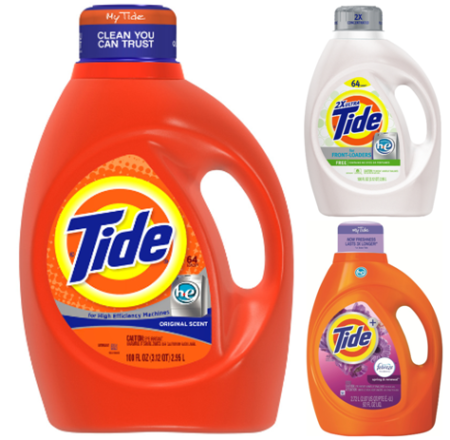Having a septic system for your home’s wastewater treatment comes with some extra responsibilities. You must be careful about what goes down your drains, as certain chemicals can damage the bacteria that digest solids in a septic tank. This is why choosing the right laundry detergent is so important.
Tide is one of the most popular laundry detergent brands in America. But is it safe to use if you have a septic system? Below we’ll explore whether Tide and other Tide products are septic-safe choices.
How Do Septic Systems Work?
To understand if Tide detergent is safe for septic systems, it helps to first know how these systems operate:
-
Septic tank – A buried, water-tight container that collects all wastewater from the home. Inside, solids settle to the bottom as sludge while fats and oils float to the top as scum.
-
Baffles – Interior walls that prevent the sludge and scum from leaving the tank before the solids can break down.
-
Anaerobic bacteria – Naturally occurring bacteria that digest and decompose the solids in the tank.
-
Drain/leach field – Perforated pipes in trenches filled with gravel. Liquid discharged from the tank flows out here and percolates into the soil.
-
Aerobic bacteria – Bacteria in the soil of the drain field provide final filtration of waste particles.
Are Tide Detergents Septic Safe?
Tide liquid laundry detergents are generally considered safe for septic systems when used properly in the recommended amounts. The ingredients are not as natural or eco-friendly as some green detergents specifically designed for septic systems. But Tide won’t completely kill the essential bacteria in your tank.
Some key points on using Tide detergent with a septic tank:
-
Use only the recommended amount per load. Overuse can damage septic bacteria.
-
Liquid better than powder, which can clog pipes if overused.
-
May still contain some chemicals like bleach that could harm bacteria if used excessively.
-
Not the most environmentally-friendly option if drain field leads to groundwater.
So you can use Tide, but moderately and as directed on the bottle. And consider switching to a more natural septic-safe detergent for maximum safety.
Are Tide Pods Safe for Septic Tanks?
Tide Pods represent an easy way to get pre-measured Tide detergent for each load. The pods are wrapped in a polyvinyl alcohol-based plastic casing.
When used properly, Tide Pods should not damage septic tanks. The exterior plastic dissolves enough during the wash cycle to release the detergent inside. It doesn’t accumulate to clog pipes or vents.
However, some of the pod’s plastic casing may remain intact by the time the water enters your septic system. Over time, small plastic residues could build up inside the tank, affecting flow.
For maximum septic tank health, liquid or powder detergents are likely safer choices than single-use plastic detergent pods.
What About Other Tide Products?
Tide makes many different laundry and household cleaning items. Are they all septic safe?
Tide Free & Gentle
This sensitive skin formula leaves out dyes, perfumes, and other irritants. The biodegradable ingredients make it a good septic-safe option.
Tide Purclean
Contains plant-based surfactants and no phosphates, dyes, or chlorine bleach. A great septic-friendly Tide product.
Tide Coldwater Clean
Formulated to activate in cold water. May contain some chemicals, but safe if used properly. Good for energy-saving cold washes.
Tide Washing Machine Cleaner
Uses an oxygen-based formula to remove odors and residue from washers. Septic-safe and kills mold and bacteria.
Signs of Septic Damage from Laundry Detergents
How can you tell if the detergent you use is harming your septic tank? Watch for these warning signs:
- Slow drains or gurgling sounds from fixtures.
- Toilets backing up or overflowing.
- Wet spots, odd smells around the drain field.
- Fast-growing, bright green grass over the field.
- Algae growth in ponds near the drain field.
- Corrosion damage to system parts like the tank or pumps.
If you notice any of these issues, reduce detergent use immediately and switch to a natural septic-safe formula. Call a technician to inspect your system for damage.
Septic-Friendly Laundry Detergent Alternatives
If you want to play it safe with your septic system, try these eco-friendly detergent options:
-
Charlie’s Soap – Powder with only natural, mineral-based ingredients.
-
Eco Nuts – Made from soap berries. No chemicals at all.
-
Molly’s Suds – Certified-organic powder detergent.
-
Mrs. Meyer’s – Plant-derived surfactants and essential oil scents.
-
Seventh Generation – 95% plant-based formula, hypoallergenic.
-
Dropps – Tablets with plant-based enzymes to fight stains.
Laundry Habits for Septic System Safety
Altering your laundry routines can also help protect your septic tank:
-
Stick to the detergent amount recommended on the bottle. Never excessively overuse.
-
Do multiple smaller loads weekly rather than fewer large loads.
-
Stagger wash loads over several days to avoid flooding the tank with wastewater all at once.
-
Don’t pour grease, oils, paints, pesticides, or other hazardous chemicals down drains.
-
Use bleach and other cleaners sparingly and only as directed.
-
Install low-flow fixtures to reduce water use and wastewater volumes.
-
Consider air drying clothes rather than running the dryer after every wash.
Is Tide Safe for Septic Systems? The Bottom Line
Tide laundry detergent is relatively safe for septic systems, especially their liquid varieties. But septic-specific detergents with all-natural, plant-based formulas are less risky choices for septic tank health.
Whichever detergent you choose, using only the recommended amounts is crucial. Moderation is key when maintaining a septic system. And pay attention for any signs of damage, like foul odors or slowed drainage.
With some extra care taken in choosing products and household habits, Tide and other conventional detergents can be used with septic systems. But eco-friendly options provide maximum safety for your septic tank bacteria.
